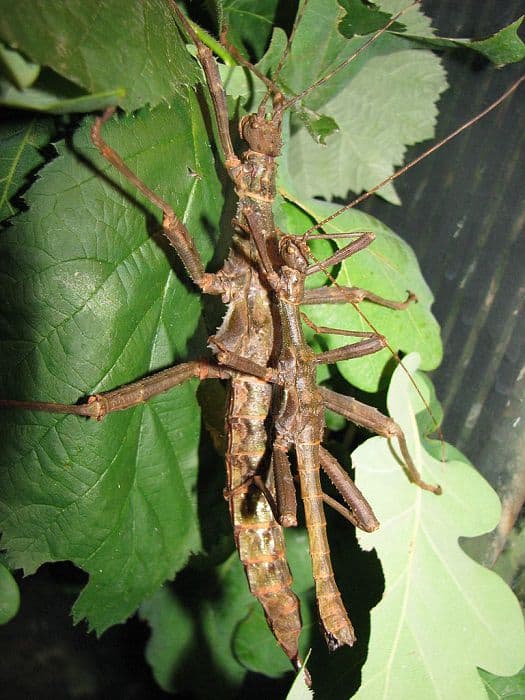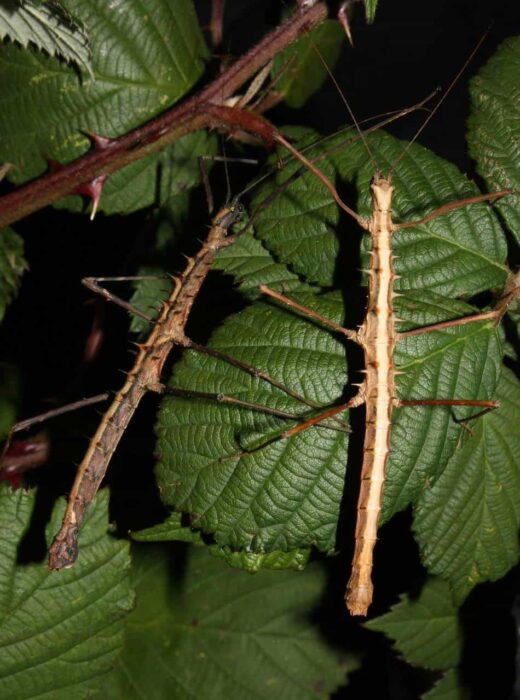Table of Contents
Stick insects are interesting creatures on many levels. A real stick insect enthusiast can sit for hours watching them do what they do. From time to time, he/she might observe two of the insects engaging in behaviour that looks a lot like fighting. It does happen, which leads to an obvious question: do stick insects attack each other?
There are varying opinions on whether or not stick insects will attack. Most people who say they will not are answering the question in ignorance.
Just about every creature on the planet will attack if it feels threatened. Stick insects are no exception and they can attack one another if provoked. This is very much species-dependent though.
For more advice and information on keeping and looking after stick insects, check out my ebook on Amazon click here
(opens in a new tab).

A Common Misunderstanding
There is a common misunderstanding among stick insect enthusiasts that their favourite creatures never attack one another. This misunderstanding is born from a couple of observations that are misconstrued.
First, stick insects are herbivores. Because there is plenty of food under normal conditions, they do not have to fight with one another to feed. Stick insects are not like lions who fail at making a kill more often than they succeed. Failing during the hunt is why lions fight over food.
It’s just assumed by a lot of people that stick insects have no reason to fight because they are herbivores. But that’s not true. Even though food supply is not an issue, there are still occasions when these creatures will attack.
The second observation is that of the stick insect’s natural tendency to either hide or flee. Stick insects do not like confrontation. As such, they will try to avoid it at all costs. If you have ever seen a stick insect drop a leg during a threatening situation, you know exactly what we’re talking about.
during a threatening situation, you know exactly what we’re talking about.
Again, the natural flight response programmed into stick insects leads many people to believe they won’t attack. But they will, given the right circumstances. Do not allow the docile nature and herbivore status of stick insects lead you to believe they are always docile.
Females Attacking Males
Moving on to explaining when and why stick insects attack each other leads us to the subject of females attacking males. Such attacks are a direct result of how stick insects reproduce.
Most species of stick insects (although not all) are parthenogenetic. This means females can reproduce with or without a male. If she lays her eggs without them first being fertilized, the insects resulting from those eggs essentially become her clones. If the eggs are fertilized by a male, they will be entirely new insects. They can hatch as either males or females.
essentially become her clones. If the eggs are fertilized by a male, they will be entirely new insects. They can hatch as either males or females.
It is also important to note that female stick insects can switch between sexual and asexual reproduction  at any time. They do this on a regular basis to maintain the right population of both males and females. And that takes us to back to the original question, do stick insects attack each other?
at any time. They do this on a regular basis to maintain the right population of both males and females. And that takes us to back to the original question, do stick insects attack each other?
If a female produces eggs parthenogenetically – which is to say without male fertilization – she will not want a male anywhere near her or her eggs. At the first sign of a male’s scent, she will go into defensive mode in order to dissuade the male from coming closer. If that male persists, she will attack him.
Likewise, stick insects moult numerous times during their lives. Immediately concluding the final moulting, females begin secreting a chemical meant to temporarily deter males from mating. The chemical puts off a pungent smell that males typically want nothing to do with. From time to time there are males that still try to mate any way.
This is another situation in which the female will do everything she can to prevent mating. A male approaching too closely will be attacked without mercy.

Combining Multiple Species
The docile nature of stick insects makes it possible to keep multiple species in the same general area. More often than not, they will not bother one another. But there are occasions when combining certain species can cause problems.
Let’s say you have two different species native to opposite corners of the world. They would never come in contact with one another in the real world, but you have chosen to house them in the same tank. You could be creating a situation in which one stick insect will attack another.
Unfortunately, there is no way to know for sure how or why this happens. There is no way to predict when it will happen either. Most stick insect species get along just fine. But you never know. It is possible to create the perfect storm that causes a member of one species to attack a member of another.
When it happens, the attack is primarily a territorial dispute. Despite the docile nature of stick insects, they can become territorial when presented with other species they don’t recognize. Thus, one stick insect that perceives its territory is being invaded may decide to attack.
Wrapping this all up, it is rare for stick insects to go on the offensive. They prefer flight over fight. However, fighting with each other is not uncommon. And when stick insects fight, one of them has to be the aggressor. So yes, stick insects do attack each other on occasion. It is a normal part of nature.

